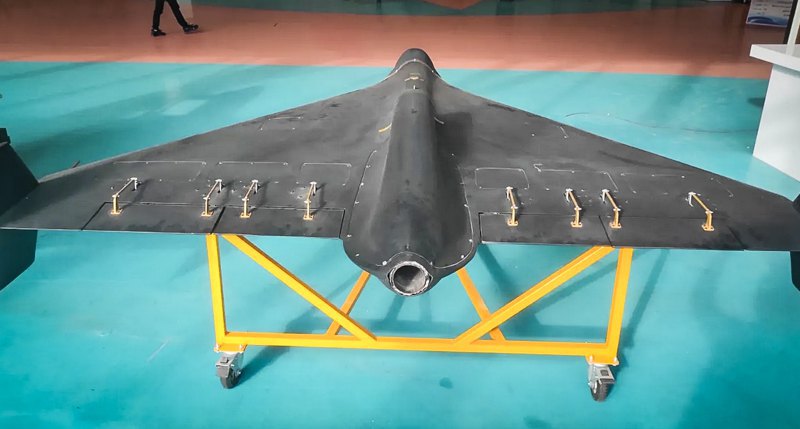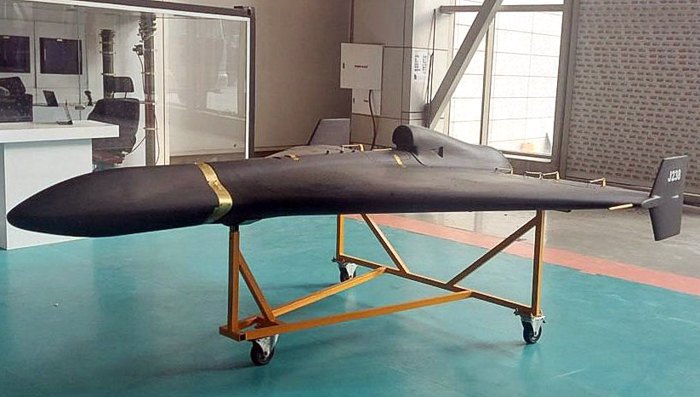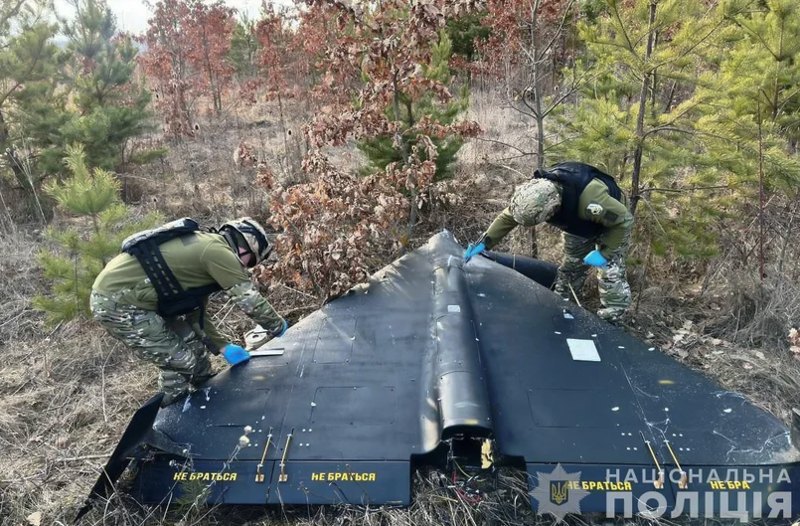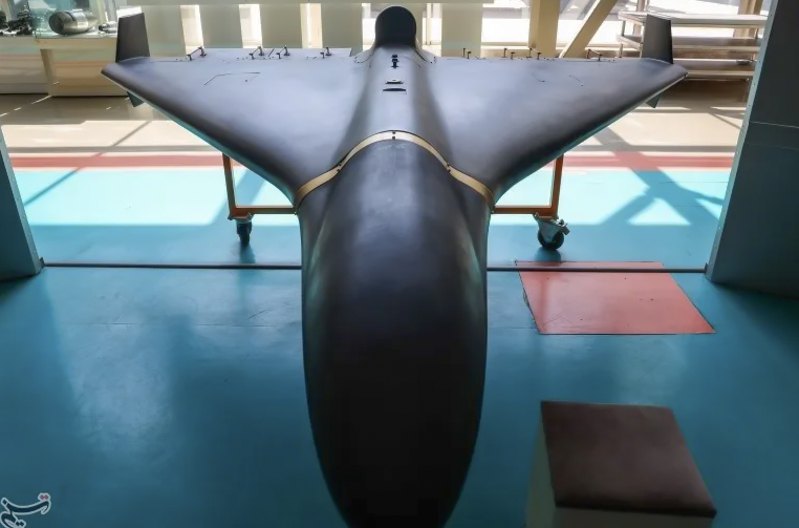
What is known about jet-powered Shaheds
The Shahed-238 strike UAV is a product of Iran’s Ashura University of Aerospace Science and Technology, presented to a Russian delegation in November 2023. Recently, the portal "Militarnyi" reported on published technical documentation that gives an idea of the UAV's specifications. It has a flight range of 1,000 km (in other documents — 2,000 km), can reach an altitude of up to 9,000 m, and travel at speeds of up to 600 km/h. The common Shahed-136, or "Geran-2", with a piston engine, has a flight range of up to 1,000 km, altitude up to 4,000 m, and a speed of about 185 km/h. The jet-powered version is 3.5 metres long with a wingspan of 3 metres. It is heavier than the Shahed-136 — 370 kg take-off weight versus 200 kg — but both models carry the same warhead of 50 kg (though Militarnyi reported that Russia may already be increasing this to 90 kg).
In February, Ukraine’s Defence Intelligence learned that Russia is setting up production of its own analogue of the Shahed-238 — the “Geran-3”, with a compact Tolou-10/13 low-bypass turbojet engine. This is expected to provide speeds of up to 550–600 km/h and a range of 2,500 km, making the UAV less vulnerable to traditional mobile fire teams with small arms or electric interceptor drones.
The Geran-3 flies too fast — there’s little time to react — and this is its main danger. “On radar, it essentially appears as a cruise missile due to its flight parameters, as its speed may exceed 500 km/h. Not all air defence assets we use today can intercept such targets,” explained an Air Force spokesman.
Fresh analysis: previous specs were promotional
The Geran-3, a copy of the Iranian original, most likely still carries a 50 kg warhead, aviation expert Valeriy Romanenko told LB.ua. The UAV's tail section differs slightly in shape due to aerodynamic adjustments required for the jet engine.

“The specifications previously announced by the media were promotional,” the expert believes. Physically, such a UAV cannot reach 600–800 km/h — a maximum of 400–450 km/h is possible due to aerodynamic limitations. It is also unlikely that the drone can cover the previously claimed 2,000–2,500 km.
“That is completely unrealistic — its range should be lower than that of the Shahed-136, as a jet engine consumes much more fuel than a piston engine. Speed increases come at the cost of range,” Romanenko explains. In reality, the flight range is 600–700 km (definitely under 1,000 km), depending on the engine’s power — which remains unknown.
There is a whole range of Chinese model aircraft engines (and the Geran-3 uses one of those, not an actual aviation engine). A more accurate estimate would require aerodynamic calculations, such as those done by a design bureau. “That’s necessary for our air defence systems to adapt to intercepting them,” Romanenko says.
Russia continues to upgrade Shaheds
Military intelligence sources told LB.ua that Russia has made several key upgrades to its UAVs. In particular, Russians have increased Shahed resistance to electronic warfare by using protected CRPA systems (controlled reception pattern antennas) and increasing the number of antenna elements from four to sixteen.
Additional modules have also appeared on the UAVs, such as LTE modems, microcontrollers, and mini-computers. Some units were found to have video cameras which, together with those components, enable transmission of video and telemetry to remote servers to improve the effectiveness of strikes and allow operators to react more quickly to changing conditions.
Intelligence experts also noted design changes, such as added components allowing the drones to operate in high humidity and cold climates.

Warheads are also evolving. In addition to the previously mentioned 90 kg warhead, analysts report the use of cumulative-fragmentation-incendiary warheads and tandem warheads to strike fortified targets.
What to use against them: classic SAMs and fighter jets
Jet-powered strike drones are currently more dangerous, as mobile fire teams and lightweight laser-guided missiles won’t have enough time to react, the aviation expert explains. At 400–450 km/h — half the speed of a cruise missile — they are already outside the effective range of such systems. Teams would have just seconds to detect, identify, aim, and fire.
It will be necessary to deploy anti-aircraft artillery with electro-optical or radar guidance (laser-guided missiles won’t suffice). Suitable systems include Gepard (German self-propelled AA gun), and light artillery systems like the German Skynex and Skyranger. SAMs such as the Avenger (US short-range SAM on a Humvee chassis), German IRIS-T, and various MANPADS (US Stinger, Soviet Igla, etc.) would work well.
“The jet engine emits strong thermal radiation, much stronger than a piston engine. Therefore, infrared-guided missile seekers of all types will respond very well,” Romanenko says. Even within cities, one could theoretically deploy MANPADS shooters (though generally shooting down drones over urban areas is undesirable).
“It’s likely that we’ll have to use full-size SAMs against them — at least initially, until we identify their vulnerabilities,” the expert adds.
Fighter jets, such as F-16s, armed with short-range missiles like the AIM-9 Sidewinder, could also be used against them — but only when the UAVs fly at sufficient altitude.

According to the aviation expert, although the Geran-3 can theoretically climb to 7–9 km, it is unlikely to do so, as this would drastically reduce its range due to high fuel consumption. If they flew even at 1,000 m altitude, that would be a gift for Ukrainian air defence. Ground and airborne radars could track them from a distance along the entire route, and various systems, including fighter jets, could destroy up to 100% of them. That’s why Russian drones rarely climb to such heights and usually fly extremely low — below 200 m (where MANPADS await).
Ineffective against the new jet model
Laser-guided systems like APKWS — which convert unguided rockets into precision munitions — are ineffective. These were previously considered relatively cheap and effective against Russian drones (and in January 2025, Ukraine’s forces used one to destroy a cruise missile for the first time).
Jet Shaheds will pass through their engagement zone too quickly — the operator won’t have time to lock on and fire before the missile even starts pursuing. Thus, these systems will remain useful only against older Shahed models.
Interceptor drones also can’t catch up with the Geran-3 — except possibly on a head-on course, but not when chasing. Even on a head-on course, the chances are slim due to high closing speeds; AI elements won’t meaningfully improve hit probability, Romanenko says. Creating a drone “curtain” would mean losing dozens for minimal effect. That’s why some experts, including Serhiy "Flash", believe the jet-powered design was Russia’s trump card — held in reserve for when Ukraine’s forces adapted to intercepting the older Shaheds with anti-drone drones, prompting another upgrade cycle.
“Some air defence systems are no longer suitable, but for others in the fight against Shaheds — jet or otherwise — nothing changes,” Romanenko concludes.

However, it still needs to be determined whether the ‘Geran-3’ and Shahed-238 drones are vulnerable to electronic warfare (EW) systems, which can knock them off course and make them lose their positional signal. According to Romanenko, the Russians have already significantly improved the resilience of Shahed drones to EW, but practical experience in jamming them must be further developed. Their improved resilience is achieved by increasing the number of peripheral patch antennas on the UAVs, which are responsible for satellite communication via GPS. To deceive a Shahed’s antenna and divert it from its target, radio jamming sources need to be deployed using the formula n–1 (where n is the number of patch antennas). When Russian UAVs were equipped with just four CRPA antenna elements, three jamming sources were enough to trick the drone into following a false route favourable to Ukrainian defences. But as the number of these elements grew to eight, twelve, or even sixteen, it has become much harder to deploy a sufficient number of jammers. The key question is which specific CRPA antennas will be installed on the jet-powered Shaheds.
Mass deployment only likely by year-end
A jet engine costs at least four times more than a piston one — $40,000–80,000 versus $10,000–15,000. This drives up the overall cost of the drone, as higher speed means greater structural demands. Russia has no difficulty sourcing such engines, Valeriy Romanenko believes — until now, only cost may have constrained large-scale production. If cheaper versions are effective, why pay more? “But now, through scaling up production, they aim to lower unit costs, which are currently at least three times higher than the Shahed-136,” he explains.
Currently, we’re likely seeing low-rate or even experimental production, but new facilities and dormitories for workers have been established in Alabuga. “It’s likely that North Korea will send its ‘slaves’ there. Russians aren’t keen on assembling Shaheds themselves — dealing with epoxy resins and other toxic materials,” Romanenko says.
According to military intelligence, in 2025 Russia's plans to produce about 40,000 strike UAVs of the Shahed/Geran-2 type and 24,000 decoys (Herbera UAVs). The short-term goal is to reach 6,000 drones per month.







